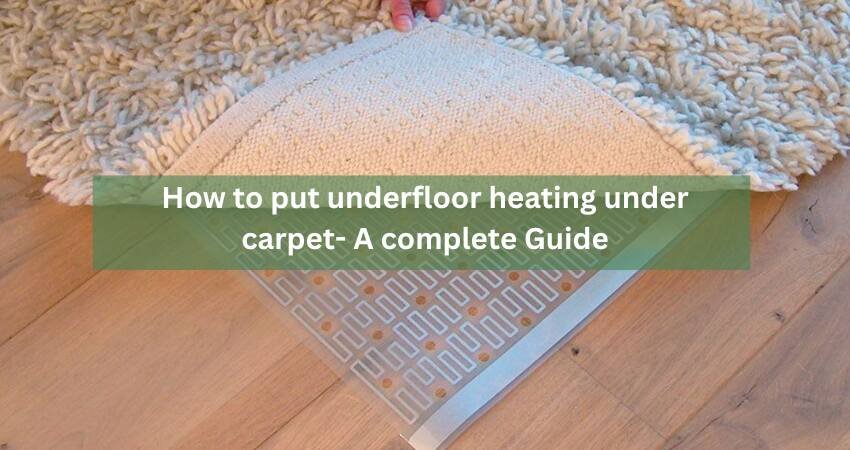Carpets are stunning floor coverings that are installed to enhance the charm and ambiance of your floors. Underfloor carpet heating is a method to get a heated underfoot experience while in harsh weather conditions. People mostly associate this heating with tile or wood flooring, which works beautifully with carpets. You should have adequate knowledge of Carpets in Dubai while installing these underfloor heating beneath floor coverings. In this study, we will learn the methods to add underfoot heating under carpets with proper planning and the use of the right tools.
Can You Install Underfloor Heating Under Carpet?
Yes, installation of underfloor heating can be done with appropriate techniques and knowledge. The flat ribbon system is the most common and easiest method to install underfloor carpet heating. In this process, these Office Carpets work as an insulator when layered with the necessary components. The heating system and underlay must be aligned and work together to pass heat efficiently to the floors. This approach will help you save energy costs.
Steps to Install Underfloor Heating Under Carpet
Choose the right underfloor heating
Choose your underfloor heating from these two main types.
Electric Underfloor Heating
This type of underfloor heating is best of compact areas or single rooms like a bedroom or a living room.
Water-Based Underflow Heating
These underfloor heating systems are perfect for larger spaces or installations. Warm water circulates in pipes below the floor to keep the Living Room Carpets warm. This system is ideal for whole-house systems but requires more focused installation.
Electric heating mats can also be considered, as they are smaller in size and do not need extensive changes to floor height.
Check carpet and underlay compatibility.
Carpets are usually poor conductors of heat, which does not mean they won’t work. It means you should choose those materials for floors that let heat pass through effectively. You only need to focus on
Thermal Resistance
The thermal resistance value of your carpet and the underlay used should not exceed 2.5. The higher the TOG value, the less heat will be passed.
Carpet Material
Wool carpets provide great insulation, thus lowering the heat transfer. You should choose low-pile or nylon carpets for better heat transfer.
Underlay Selection
You should use underlays that suit well for underfloor heating, like low TOG polyurethane foam or felt.
Prepare the Subfloor
You’d better need to prepare the floor before laying the heating system. Make sure the subfloor is
- Clean and dry
- Level and smooth
- Dust and debris-free
Install insulation Boards
Install the insulation boards below the heating system, which helps in reflecting the heat upward while preventing energy loss into the subfloor. These boards reduce warm-up time and improve energy efficiency. You can also consider high-density foam insulation boards that are compatible with electric mats.
Lay the electric heating Mat.
For laying the electric heating mat or cable, you should follow these steps.
- Roll out the electric heating mats across the prepared floor.
- Avoid overlapping wires or cutting the actual cable.
- To change the direction, cut the mesh.
- Keep the spacing consistent throughout and follow the manufacturer’s layout plan.
Ensure that the heating only covers the intended area. There should be no heating under furniture items, as it will block the airflow.
Connect the system to the thermostat.
Seek a professional electrician to connect the heating mat to an advanced thermostat. Usually, thermostat kits come with a sensor probe, which is placed between heating cables to monitor floor temperature.
Place the thermostat on the wall at a standard switch height.
Cut off all the power supply before starting electrical work.
Test the System
Always test the system before placing the carpet. Follow these steps to test the system.
- Use a multimeter to check the resistance of heating wires.
- Turn the system on briefly to ensure it is heating evenly.
- Follow all the instructor’s guidelines to avoid any mishap or hassle.
These steps will help you avoid the issues once the carpet is laid.
Install the underlay and carpet.
Once you are sure about the fine working of the heating system, proceed according to these steps:
- Lay the approved underlay carefully over the heating mat.
- Make sure there is no compression or shifting of wires.
- Do not use strong adhesives that may damage the cables.
Install the carpet on top using standard stretching and fitting techniques. Do not use metal grippers or staples near heating wires.
Tips to Ensure a Safe and Efficient Installation
- Always consider a qualified electrician for the final electrical connection of heating wires.
- Avoid placing heavy furniture and thick rugs over heated carpet zones.
- Use a programmable thermostat to regulate temperature and save energy.
- Let the floor acclimate for 48 hours before the first use.
- Never turn on the heating while gluing the carpet.
Conclusion
Underfloor heating under carpet is a fantastic way to add coziness and luxury to your space. With the use of the right materials and following installation practices from the manufacturer, you can achieve a warm floor. It helps in creating a welcoming environment all year round for your bedrooms, nurseries, and TV lounges.
Are you willing to install underflooring heating? Reach Rugs and Carpets to seek professional services to ensure everything works perfectly and safely.






